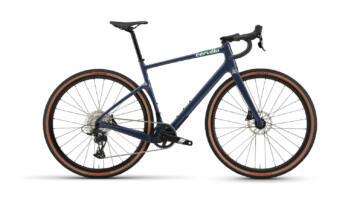
Tough, all-out racing turns to smiles after the Junior Women 13-14 race at 2013 Nationals. © Cyclocross Magazine
You may be asking, “What’s with all the hype?” or “Why would I want to race in the mud?” or “What makes cyclocross the best kind of bike racing?” If you even need to ask, your first step is to go to a cyclocross race—any cyclocross race—to check out the scene and racing action. Can’t find one this weekend? Check out this video on YouTube to see a diverse sampling of cyclocross:
Back? Good. You’ve seen it, so you probably don’t need any more convincing as to why ’cross is better… But, if that didn’t convince you, the number one reason it’s the best is the many different ways that it’s accessibility to everyone. You don’t have a team? No problem. No cycling clothing? Not an issue. No cyclocross bike? “Run what you brung.” No team, no gear, no bike? Come hang out and watch! Cyclocross is the most welcoming of the cycling disciplines, and while the Elite racing can be extremely professional and an exciting show, cyclocross embraces its goofy side as well. Don’t believe us? Check out the World Championships reports for the pro side, and the Singlespeed World Championships report for the goofy side.
First part: the bike. Regardless of what your current bike is, chances are high that a few small modifications will make it ready to tackle a ’cross race. The fact that mountain bikes are allowed (most of the time), as well as hybrids, touring bikes, and road bikes mean that there aren’t very many acceptable excuses for holding out.
Another huge factor in ’cross’s accessibility is the minimal training commitment relative to mountain or road racing. The short durations mean that those with families and/or time consuming jobs can still be competitive without endless hours of training. A little sacrifice is necessary, but a one hour ride after work is much easier to schedule than a three hour training ride for a road race. Check out our training tips here.
Preparing for a beginner road race necessitates a solid time commitment for the weeks leading up to the event. Riders must be able to hold the same pace as the pack for 30 miles or so (or 40 minute crit). If a rider can’t keep up, he/she will be pulled from the crit after being lapped, or they’ll be in for long and lonely ‘training ride’ on the road back to the finish. No fun, and it doesn’t feel like racing.
In ’cross, you’ll never have to be worried about being left all alone on the road. Even if you can’t keep up with the leaders, the whole string of riders will still be visible in front of you. You may not be competing for first place, but battling with the guys closest to you before edging them out in the last sprint is pretty satisfying. Clydesdale and Athena divisions are often available for racers who are of a certain size and up.
And lastly, there’s always the joy of spectating. Racing within a reasonable driving distance means that both friends and family might be interested in tagging along for the day. Kids can watch their moms and dads playing in the mud, and there are even kids’ races that they can try. All friends need to know is that there will be beer, and that they will be able to heckle you throughout. Spectators of all ages can have a great time watching the nearly constant stream of racers passing by. It’s much more engaging than a road race where you might not see the riders again until they finish three hours later.
Get schooled in cyclocross with our Cyclocross Academy class list here, and make sure you’re subscribed to Cyclocross Magazine, your guide for getting into the sport, and upping your ’cross knowledge. Not subscribed yet? For the newbies, our Issue 21 has a great feature on buying your first cyclocross bike, and Issue 22 has a story on how to get into racing and what to expect at your first race.
Thanks to Mathew Shimoko for leading our FAQs effort.




























